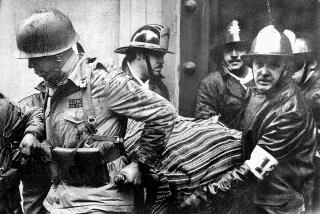Cuba Releases Documents on Bay of Pigs Invasion
- Share via
HAVANA — A young Fidel Castro joked and swore as he barked out orders by telephone to defending troops at the Bay of Pigs 40 years ago, according to Cuban documents declassified this week at a conference bringing together former opponents in the battle.
“I think that up to now you have been missing the party,” Castro told his younger brother, Raul, who was far from the fighting the morning of April 17, 1961, shortly after the three-day invasion began. Then turning serious, the 34-year-old military commander added: “But you had better be ready.”
Later in the day, calling from a sugar mill near the battlefield, Castro shouted to another military chief: “Tomorrow we are going to shoot down planes, but today we have to sink ships.
“Sink ships! Sink ships, [expletive]! You have to sink ships! [Expletive], fire at them!”
Much of Castro’s communications were with Jose Ramon Fernandez, then a captain and now a retired general who led defending troops on the beach known here as Playa Giron.
“We are going to wipe them off the map with mortars!” Castro tells Fernandez, now a vice president in the Cuban government and one of the conference organizers.
Also made public for the first time were two Cuban intelligence documents written before the invasion, the first a detailed Jan. 12, 1961, report on the camps in Central America and Florida where the anti-Castro exile forces were trained.
The report also mentions articles by U.S. newspapers about what was supposed to be a secret training camp for the invasion force in Guatemala, demonstrating that U.S. plans to invade Cuba were well known months before.
Another Cuban document, written by intelligence officials two days before the invasion, showed that Havana was well aware of a division within the Kennedy administration over invasion plans.
After the failed operation, five invaders who fled the fighting and sought asylum at the Brazilian Embassy in Havana determined that only a direct U.S. military attack could have dislodged the Castro government, according to a declassified Brazilian document.
Without ammunition and U.S. air support, more than 1,000 invaders were captured in the disastrous operation. An additional 100 invaders and 151 defenders died.
Castro attended the conference, along with five former members of the invasion and former Kennedy special assistants Arthur M. Schlesinger Jr. and Richard N. Goodwin, who both thought the invasion was ill-advised.
More to Read
Sign up for Essential California
The most important California stories and recommendations in your inbox every morning.
You may occasionally receive promotional content from the Los Angeles Times.













